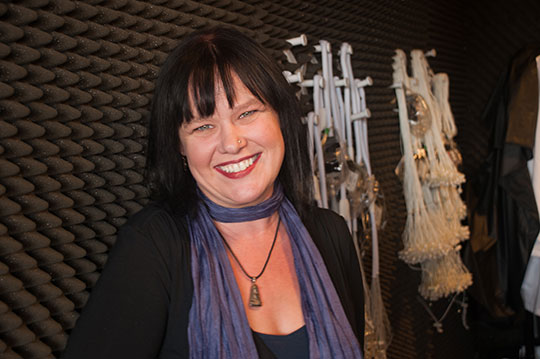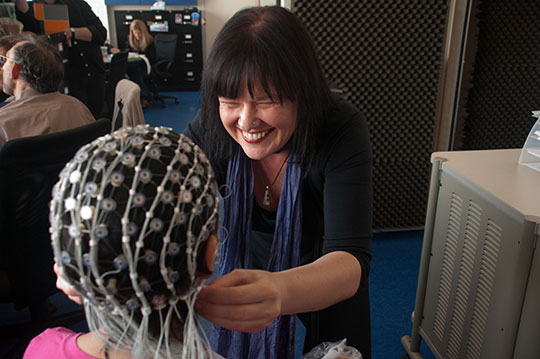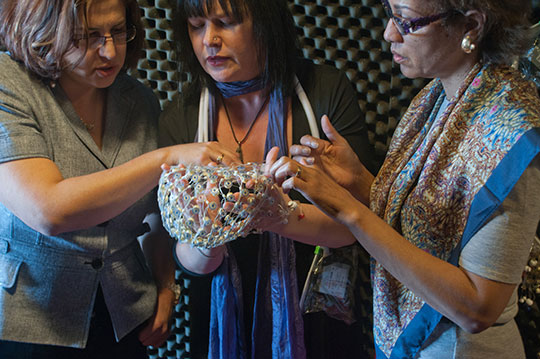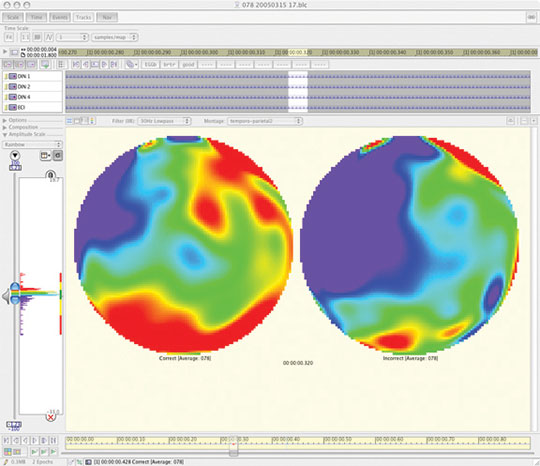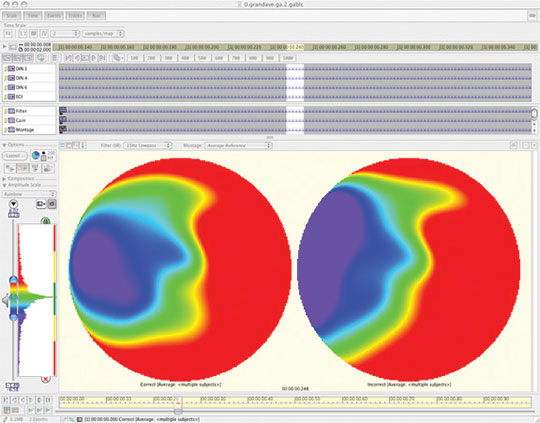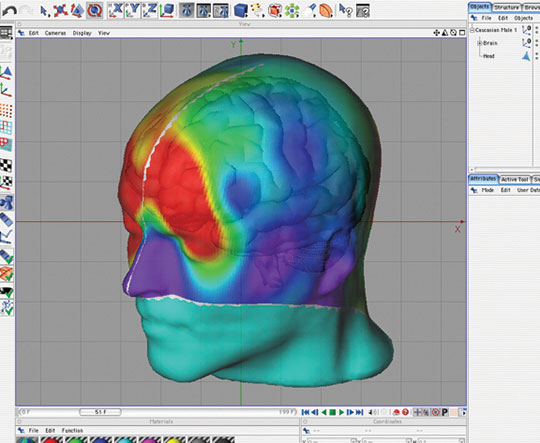Backstage at the Human Drama
Karen Froud is using EEG technology to understand how brain differences shape behavior
Karen Froud is using EEG technology to understand how brain differences shape behavior
By Joe Levine
Photography by Heather Van Uxem Lewis
In 2010, while visiting Southeast Asia, Karen Froud had her left forearm tattooed—in Cambodian—with the words “With our minds, we make the world.”
For Froud, Director of Teachers College’s Neurocognition of Language Lab, the tattoo does more than complement an edgy look that includes hennaed hair and a wardrobe that tends toward black. She interprets the ancient Buddhist adage literally: The brain—that three-pound lump of 100 billion cells—shapes all our experiences.
“Looking at behavior alone tells us only a fraction of what’s really going on,” says Froud, Associate Professor for the programs in Speech–Language Pathology and Neuroscience and Education. “Observable behavior is the end result of many, many processes that happen behind the scenes. Behavior can look very similar from one person to the next, but when we look at what the brain is doing, that’s where we see differences.”
Froud and her students use brain-imaging technologies to look “behind the scenes” in children with speech disorders, adults who are learning to read, people who speak multiple languages and even longtime practitioners of meditation. Their work has ranged from research on language processing to studies of the brain systems used for thought and conceptual understanding.
“When we look at children who have speech disorders, looking at the brain instead of behavior could help us identify more accurately whether they have problems with motor planning or with some linguistic aspects of speech production or perception,” Froud says. “When we look at adults who are just learning to read and who find it hard to hang on to that skill, looking at the brain instead of behavior enables us to begin seeing what is different about how their brains handle reading. Maybe one day we can use that knowledge to develop more effective teaching approaches.”
Indeed, such points of difference in brain function can now be identified with much the same precision as variations in human genes—and could someday be just as useful in developing effective therapeutic interventions.
Several years ago, for example, Froud conducted an experiment in which she examined the brain function of people with schizophrenia while they performed simple tasks involving language. While their brain activity was being recorded, participants listened to a spoken word and then were shown another word on a screen. Their task was to decide if the word on screen was an actual word or simply a nonsensical string of letters. People with no neurological disorder can make such determinations more quickly if the word they hear (say, hospital) is related to the word they see (“doctor”)—a process called priming.
In Froud’s study, the participants with schizophrenia, who were high-functioning, stable people on medication, behaved just like those with no neurological problems. They completed tasks well and showed a priming effect. But using a technology called magnetoencephalography (MEG), Froud saw that their brains were not processing information typically. MEG records magnetic fields associated with the electricity generated by brain cells as they communicate with one another. In most people, word-recognition tasks elicit a very specific magnetic field, a kind of neural signature. But in the people with schizophrenia, that signature was distorted or absent, or other unexpected responses were occurring in different parts of the brain. For Froud and her team, these changes indicated that basic brain operations are disrupted and disorganized by disorders such as schizophrenia, even when the behavior of affected individuals appears normal.
No one has yet devised a targeted therapy for complex problems like these, but Froud definitely has some ideas. One afternoon a few years after completing the schizophrenia study, she hosted three Buddhist monks from Thailand in her lab. Other researchers had previously observed that meditation increases the organization, or coherence, of activations in different brain regions, and Froud was keen to witness the phenomenon herself.
“We did some simple sensory experiments, recording brain data while the monks listened to sounds, before, during and after meditation,” she says. In two of the monks, who were younger and had practiced meditation for about 15 years, the effects were unsurprising: very typical brain activations before meditation that became much more coherent and organized during meditation. Afterward, a residual coherence could still be seen, although to a lesser extent.
But when Froud tested the third monk, who was a Rinpoche, or lama-like elder, the results were so striking she thought at first her lab equipment was malfunctioning. “The brain data looked extremely organized—unusually so—all the time,” she says. “When I asked the Rinpoche how that could be, he told me he was always meditating, even when he was speaking to me.”
Since then, Froud has been mulling over possible therapeutic effects of meditation for people with various neurological disorders. This spring, she’ll begin a study of cognitive processing in people who are experienced meditators versus those who are novices at the discipline.
A POINT OF CONVERGENCE
TO THE LAY EYE, THE SPIKY GRAPHS GENERATED BY THE 128-channel electroencephalography machine housed in Froud’s lab on the 11th floor of Thorndike Hall aren’t nearly as exciting or interesting as the pictures of brains produced by technologies such as fMRI (functional magnetic resonance imaging) and PET (positron emission tomography). With those tools (and some hefty computerized enhancements) you can look into someone’s brain and see just where activations are occurring. Yet EEG-derived information is often much more useful, because it tells you when those activations are occurring. It can pinpoint to within milliseconds the brain’s response to a specific stimulus and then follow the processing of that response in real time. “We can look at the temporal unfolding of word recognition, or syntactic structure building, or almost any cognitive process,” says Froud.
Froud uses fMRI, too, and by combining different imaging modalities has been able to create a multilayered understanding of how activity in different brain regions unfolds over time, more akin to a flow chart of symphonic interaction than to a static portrait.
“For us, it’s about understanding the intersection of timing, localization, concentrations of neurotransmitters [chemicals the brain uses as signal conductors] and the interactions of multiple systems,” she says. “What’s so wonderful about the technology is that we can look at the brain and say, ‘What’s behind this behavior?’ rather than having to work backward from external observations, as earlier scientists like Thorndike and Dewey did.”
Froud’s own career trajectory reflects a shift from looking at outward behavior to focusing on brain function. She worked as a speech/language therapist in London, treating patients who were recovering from traumatic brain injuries or emerging from comas, and then studied linguistics at University College London. It was her postdoctoral training, in London and then at MIT, that afforded her an opportunity to acquire hands-on skills in neuroscience. Perhaps because she discovered technology via that circuitous path, she understands both its allure and its application for people working in other disciplines.
In recent years Froud has worked with George Bonanno, a clinical psychologist looking for brain markers that might predict which people are at risk for suffering prolonged grief after a bereavement (see story on page 40); Sami Boudelaa and Reem Khamis-Dakwar, Arab linguists working on understanding the cognitive representation of different Arabic language varieties; John Black, who directs TC’s Cognitive Science program, and his doctoral student, Chaille Maddox, to understand different modes of nonlinguistic reasoning; and Laura Sánchez and Paula García, doctoral students from Colombia and the Dominican Republic, respectively, to understand second-language acquisition processes.
“Karen is very open to allowing all of us to pursue the questions we’re interested in,” says Khamis-Dakwar, who earned her Ph.D. in Speech–Language Pathology at TC in 2007 and is now Assistant Professor of Communication Science and Disorders at Adelphi University. Khamis-Dakwar, who is a Palestinian with Israeli citizenship, is collaborating with Froud to study Arabic diglossia, or linguistic duality. In Palestinian communities, as in most other Arabic countries, people speak an Arabic dialect while writing in Modern Standard Arabic. This has led to clashes over approaches to teaching, sometimes with political overtones.
“There was so much resistance to studying this diglossic situation, and many were even accused of taking a Westerner’s viewpoint just by discussing it,” Khamis-Dakwar says. “Some researchers have argued that diglossia is the cause of all our literacy problems, claiming, ‘This is the reason why Arabs don’t like to read.’ Personally, I am interested in studying this unique situation, and at the same time I want to keep Standard Arabic and the rich access it provides to all the different Arabic-speaking communities and cultures.”
But there is no question that diglossia creates unique challenges for children as they learn, particularly, Khamis-Dakwar says, in an educational system that is mainly trying to mimic educational practices developed for children who live in non-diglossic communities. For Froud and Khamis-Dakwar, the issue is not to be “for” or “against” but simply to understand those challenges for what they are and to help create more effective methods for teaching Arabic as both a first and a second language.
To that end, the two have examined brain responses of Arabic-speaking participants listening to diglossic code-switching—that is, alternations between colloquial Palestinian dialect and Modern Standard Arabic within single sentences. “This study was based on findings from previous work that showed that the brain responds differently to code switches between English and Spanish—such as hearing the sentence ‘I knocked on the puerta’ instead of ‘I knocked on the door’—compared with hearing an unexpected word in English, like ‘I knocked on the entrance,’” Khamis-Dakwar explains.
“If Arabic dialects are really just register variations of Modern Standard Arabic, then we would expect to see one kind of brain response to diglossic code-switching in our study,” she says. “But if the dialect really functions as a separate language system, then we’d see a different signature.”
They did, in fact, see a pattern of activation that suggests that Arab dialects are handled in the brain as distinct systems. While the finding has perhaps not rocked the Arab world, it has, in a quiet way, begun to change some thinking. At least one prominent university faculty member in the Mideast has told Khamis-Dakwar he now plans to teach colloquial Arabic before Standard.
“We’ve been able to take some of the political noise out of the situation,” she says.
Meanwhile, she adds, the findings have potential application in the United States, where many African-American children who speak a vernacular English at home run into problems in classrooms where the lingua franca is Standard English. “If we can incorporate studies of these two situations [Arabic diglossia and African-American Vernacular English speakers in the U.S.] and understand the representation of these systems in the brains of these children, we could devise better strategies to help them transition more successfully from their home language environment to their school language environment,” Khamis-Dakwar says.
FOOD FOR THOUGHT
IN RELATED RESEARCH, CHAILLE MADDOX, A PSYCHOLOGY Ph.D. student working with Froud, has been exploring a different kind of cognitive dualism: the mind’s ability to reason using, on the one hand, abstract representations and logical rules, and on the other, sense-based perceptions.
“Psychologists and philosophers both say that when we think, we manipulate an incoming stimulus by creating a mental representation of it,” says Maddox. “In one view of how we do that, the content is made symbolic, unrelated to our senses, and we process it by applying rules. But another view of reasoning remains based in our senses. We take something visual, for example, and we build associations. We see round things rolling and bouncing, and we infer that other round things do that too.”
Since ancient Greek times, Maddox says, there’s been a bias in favor of symbolic reasoning, the notion “that symbolic, logical reasoning is superior because it involves language, and language is what separates us from other animals.” So Maddox designed a series of experiments that “take language out of the picture.” Participants were shown on-screen images of, say, four interlocking gears in motion. They were trained to predict the direction of motion for a fifth gear, either by forming a sensory representation (visualizing the sequence of directional changes as the gear teeth engage) or by applying an abstract rule (odd-numbered gears in a sequence turn clockwise, even-numbered gears turn counterclockwise).
Maddox predicted distinct neural signatures for the different reasoning approaches, and that’s exactly what the EEG recordings showed. Responses in the brains of participants using the first approach were consistent with forming associations among visual/spatial perceptions, whereas the second approach elicited brain responses consistent with the abstract representation of rule-governed processes.
The results are significant for several reasons. First, they strongly suggest that these specific neural signatures, which until now have been understood mainly as indicators of language processing, are also evidence of broader cognitive processes, a finding that could pave the way for new areas of research. For example, the discovery of distinct neural signatures for different modes of reasoning could provide a way to validate teaching practices such as the use of math manipulatives and other hands-on methods that help establish relationships between numbers and formulas and the quantities and processes they represent.
In the longer term, much to the delight of cognitive psychologist John Black—Maddox’s adviser and a longtime supporter of Froud’s work—the findings could shed new light on the teaching potential of iPads and other technology that provides people with learning experiences rooted in touch, vision and hearing.
For Froud, the findings also underscore the value of collaboration itself. “Neuroscience isn’t something you can or should do by yourself,” she says. “Working at TC has broadened my experience in a way that no other institution could. Only here would I have the opportunity to collaborate with so many different people and study such a range of phenomena and behaviors, and to think about it all in the framework of what’s actually going on in society. It’s a constant reminder that one day what we’re doing could make a difference in how we treat a particular disorder or help people learn more easily, or enhance our understanding of other cultures. It’s our joy and privilege to have that as our cornerstone.
“We can’t get upset when our hypotheses are wrong or our understanding is partial,” she adds. “We just have to keep going. My doctoral adviser used to tell me, ‘You’ll never be right; the best you can hope for is to be wrong in interesting and useful ways.’ I find that reassuring.”
Published Thursday, Dec. 15, 2011
